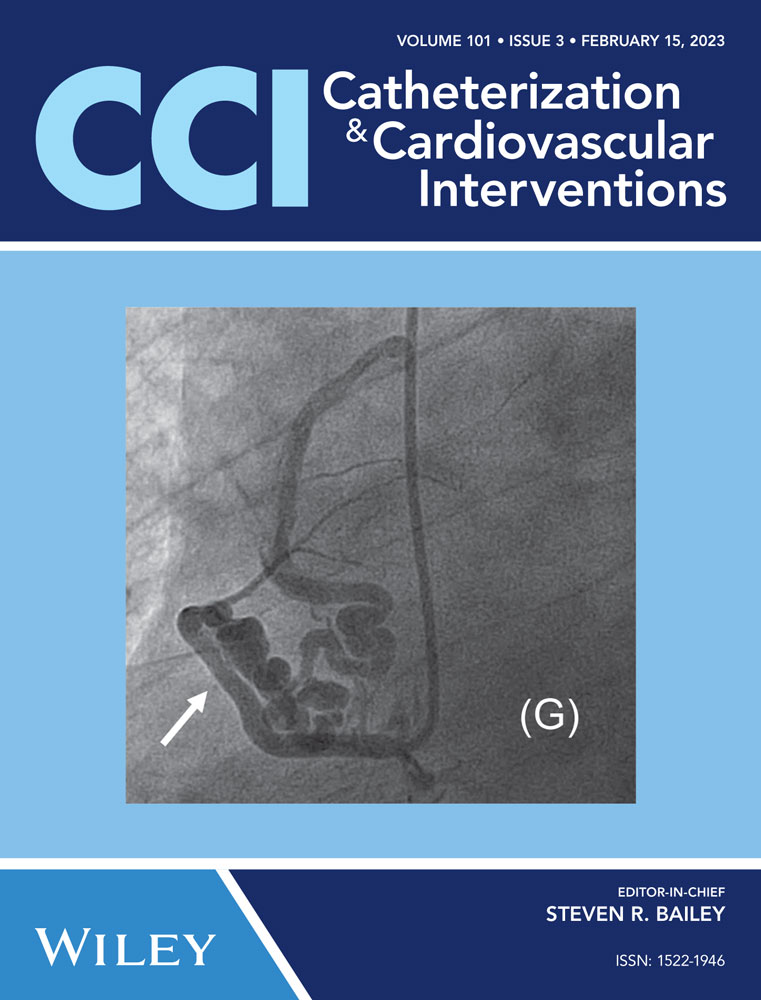Impact of technique on bifurcation stent outcomes in the European Bifurcation Club Left Main Coronary Trial
Abstract
Background
Techniques for provisional and dual-stent left main bifurcation stenting require optimization.
Aim
To identify technical variables influencing procedural outcomes and periprocedural myocardial infarction following left main bifurcation intervention.
Methods
Procedural and outcome data were analyzed in 438 patients from the per-protocol cohort of the European Bifurcation Club Left Main Trial (EBC MAIN). These patients were randomized to the provisional strategy or a compatible dual-stent extension (T, T-and-protrude, or culotte).
Results
Mean age was 71 years and 37.4% presented with an acute coronary syndrome. Transient reduction of side vessel thrombolysis in myocardial infarction flow occurred after initial stent placement in 5% of procedures but was not associated with periprocedural myocardial infarction. Failure to rewire a jailed vessel during any strategy was more common when jailed wires were not used (9.5% vs. 2.5%, odds ratio [OR]: 6.4, p = 0.002). In the provisional cohort, the use of the proximal optimization technique was associated with less subsequent side vessel intervention (23.3% vs. 41.9%, OR: 0.4, p = 0.048). Side vessel stenting was predominantly required for dissection, which occurred more often following side vessel preparation (15.3% vs. 4.4%, OR: 3.1, p = 0.040). Exclusive use of noncompliant balloons for kissing balloon inflation was associated with reduced need for side vessel intervention in provisional cases (20.5% vs. 38.5%, OR: 0.4, p = 0.013), and a reduced risk of periprocedural myocardial infarction across all strategies (2.9% vs. 7.7%, OR: 0.2, p = 0.020).
Conclusion
When performing provisional or compatible dual-stent left main bifurcation intervention, jailed wire use is associated with successful jailed vessel rewiring. Side vessel preparation in provisional patients is linked to increased side vessel dissection requiring stenting. Use of the proximal optimization technique may reduce the need for additional side vessel intervention, and noncompliant balloon use for kissing balloon inflation is associated with a reduction in both side vessel stenting and periprocedural myocardial infarction.
Clinical Trial Registration
ClinicalTrials.gov Identifier NCT02497014.
CONFLICTS OF INTEREST STATEMENT
D. H.-S. is a proctor/advisory to Boston, Abbott, Medtronic, Terumo, Edwards, Occlutech, Gore; CERC. A. C. is a Consultant at Abiomed, Biosensor, Magenta and received Speakers fees from Abbott vascular, Abiomed, Boston Scientific, Cardinal Health. T. L. lectures Abbott Proctoring, Edwards Proctoring, Lectures, Boston scientific, Terumo Proctoring. M.-C. M. is a Shareholder and CEO of CERC. M. P. received Lecture fees Abbott, Boston. J. F. L. received Lecturing and Honoraria for Medtronic, Boston Scientific, Biotronik, Biosensors. A. B. received lecture fees Boston. O. D. received lecture fees for Boston and Edwards. F. B. received lecture fees from Abiomed, Abbott, Medtronic, Terumo. M. E. received honoraria, proctorship and speaker's fee for Abbott Vascular, Boston Scientific, Philips, Spectranetics, Volcano, Vascular Perspective, Merrill, Sveltte, EPS Medical, Astra Zeneca. G. S. received speaker fees from Medtronic, Abbott Vascular, and Terumo. M. S. received honoraria for Medtronic, Edwards Lifesciences, Abbott, Boston Scientific, and Gore. D. M. is a consultant for Medtronic, Boston Scientific, and Microport. The remaining authors declare no conflicts of interest.
Open Research
DATA AVAILABILITY STATEMENT
The data that support the findings of this study are available from the corresponding author upon reasonable request.




